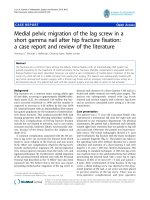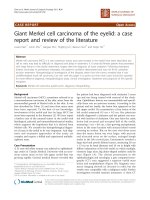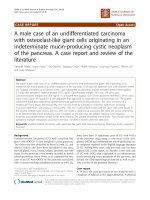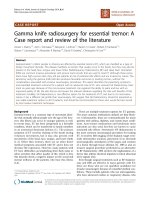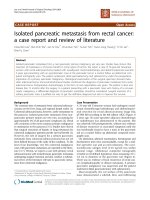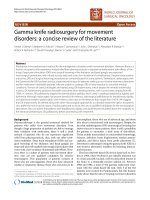Báo cáo khoa học: "Gamma knife radiosurgery for essential tremor: A Case report and review of the literature" ppsx
Bạn đang xem bản rút gọn của tài liệu. Xem và tải ngay bản đầy đủ của tài liệu tại đây (2.79 MB, 7 trang )
CAS E REP O R T Open Access
Gamma knife radiosurgery for essential tremor: A
Case report and review of the literature
Ameer L Elaimy
1,2
, John J Demakas
1,4
, Benjamin J Arthurs
1,3
, Barton S Cooke
1
, Robert K Fairbanks
1,5
,
Wayne T Lamoreaux
1,5
, Alexander R Mackay
1,6
, David R Greeley
7
, Christopher M Lee
1,5*
Abstract
Approximately 5 million people in America are affected by essential tremors (ET), which are classified as a type of
benign movement disorder. This disease manifests as tremors that usually occur in the hands, but they may also be
present in the head, face, tongue, and lower limbs. Radiofrequency thalamotomy (RF) and deep brain stimulation
(DBS) are common invasive procedures with proven track records that are used to treat ET. Although these proce-
dures have high success rates, they still put patients at risk of potential side effects and are invasive by nature. Tha-
lamotomy using the gamma knife (GK) also produces favorable outcomes in treating tremors, without the
complications associated with invasive neurosurgery procedures. This report describes the presenting symptoms
and extended treatment outcome for a patient with an advanced case of ET, who received GK thalamotomy treat-
ment six years ago. Because of this non-invasive treatment, she regained the ability to paint and live with an
improved quality of life. We also discuss and review the relevant literature regarding the risks and benefits of this
treatment modality. GK thalamotomy is one effective option for the treatment of ET, and due to its noninvasive
nature, it has a different risk profile than neurosurgery. We suggest that GK thalamotomy should be presented as
one viable treatment option to all ET patients, and should be recommended to those who would be best served
by less invasive treatment techniques.
Background
Essential tremor is a common type of movement disor-
der that normally affects people over the age of 65; how-
ever, this illness can occur in younger patients as well.
In recent years, ET has been categorized as a heritable
condition, which can be transferred to family members
in an autosomal dominant fashion [1]. The primary
symptom of ET involves shaking of the hands during
voluntary movements, but it may also present with
movements of the head, face, tongue, and lower limbs
[1-3]. Other than tremors, there are no other direct
medical symptoms associated with ET and it does not
decrease life expectancy. However, many patients with
ET have difficulties accomplishing their daily tasks or
other activities that affect quality of life, which is how
this disorder elicits a negative impact on the social and
mental wellness of the patients who bear this illness
[1,4].
There are multiple t reatment options for ET patients.
The most common medications utilized are beta-block-
ers. Unfortunately, these are contraindicated for many
patients with asthma, diabetes, and certain heart condi-
tions. Anti-seizure medications and botulinum toxin
injections are also used, but they are known to ca use
unwanted side effects. Stereota ctic RF thalamotomy is
the most com mon neurosurgical procedure for treating
ET. It involves MR imaging of the thalamic target (ven-
tralis intermedius nucl eus), placement of an electrode
neurosurgically, stimulation of the target, and creation
of a lesion through tissue ablation [5]. DBS is also an
invasive surgical procedure performed as an alternative
to RF thalamotomy. DBS involves the implantation of a
device that utilizes electrical impulses to block abnormal
nerve signals [5,6].
Even though surgical treatment s such as RF thalamot-
omyandDBSareeffectiveinmanypatientswithET,
there are those who are not qualified candidates for
invasive neurosurgery because of comorbid medical con-
ditions. These include patients who use anticoagulants,
who have advanced cardiac or respiratory disease, who
* Correspondence:
1
Gamma Knife of Spokane, 910 W 5
th
Ave, Suite 102, Spokane, WA 99204,
USA
Elaimy et al. World Journal of Surgical Oncology 2010, 8:20
/>WORLD JOURNAL OF
SURGICAL ONCOLOGY
© 2010 Elaimy et al; licensee BioMed Cent ral Ltd. This is an Open Access article distributed u nder the terms of the Creative Commons
Attribution License ( which permits unrestricted use, distribution, and reproduction in
any medium, provided the original work is properly cited.
are known to be noncompliant, and who are of
advanced age. An alternative for such patients is thal a-
motomy using GK radiosurgery. GK thalamotomy is a
safe alternative to invasive neurosurgery, and e vidence
shows it is successful in the treatment of ET and similar
movement disorders [5,7-11]. Also, because this disorder
often occurs at a late age, and pharmaceuticals can have
significant side effects, GK can be the only treatment
option for this population of medication-intolerable
patients.
We present an inspiring case of an ET patient, whose
daily life was drastic ally modified by the severity of her
hand tremors, until GK thalamotomy treatment restored
her ability to control movement and pursue her passion
of painting.
Case Presentation
Case Report
The patient was a 65 year -old right-handed female, who
reported a history of right-handed tremors for approxi-
mately one to two years before her GK consultation in
2003. The tremors involving her right arm were fine
postural tremors, as wel l as intentional tremors. She did
not experience resting tremors. Also, the patient experi-
enced fine tremors in her left arm. She found that the
tremors were more pronounced w ith stress. Eventually,
the patient’s handwriting worsened to the point where
she was no longer able to write legibly (See Fig. 1). The
patient worked as a nurse, and said certain aspects of
her job became difficult to accomplish (e.g. administer-
ing IVs) because of her tremor. The patient was initially
treated medically for her tremor, but she did not experi-
ence significant relief and thus sought out other treat-
ment options.
She consulted with a neurosurgeon, with the goal o f
learning the risks and b enefits of the available surgical
procedures. In her case, DBS was felt to be a better
option than RF thalamotomy. She was educated about
the risks and bene fits of DBS and GK thalamotomy and
opted to proceed with GK treatment. After an MRI was
obtained and GK planning was complete, the patient
underwent a left VIM thalamotomy, w ith a prescribed
maximum dose of 140 Gy. The dose administered was
70 Gy to the 50% isodose line , with a 4 mm gamma
knife shot. Following the procedure, the patient was
monitored closely and had serial follow-up appoint-
ments with a neurosurgeon. We have included an illus-
tration of her treatment fields (See Fig. 2).
The patient did well post-operatively and experienced
no side effects or focal neurological problems. The patient
first observed tremor improvement within two weeks of
radiosurgery. Tremor control continued to improve over
the next eight months. At that point, the patient’stremors
completely dissipated (See Fig. 3). Because of her profound
improvement, the patient painted a beautiful picture for
her treating neurosurgeon out of gratitude for her
regained ability (See Fig. 4). United Parkinson’s Disease
Rating Scale (UPDRS) scoring and the Fahn-Tolosa clini-
cal rating scale were utilized to provide an objective mea-
surement of response to treatment [12,13]. We compared
scores from pre-treatment with scores eight months aft er
treatment to demonstrate her clinical impr ovements.
Assessment by the treating neurosurgeon revealed that the
patient’s sco ring improved from a grade of 3 to 0, with
respect to handwriting and tremor control in both the
UPDRS and the Fahn-Tolosa scales. It was also concluded
that the patient’ s drawing capability improved from a
grade of 4 to 0 by Fahn-Tolosa grading. A post-treatment
MRI eight month after radiosurgery showed an 11 mm
enhancing ring-like lesion consistent with the treatment
(See Fig. 5).
Unfortunately, the patient did experience complica-
tions one year after GK surgery. She developed numbness
in the first three fingers of her right hand and her tongue,
which led to dysarthria. The patient also reported balance
problems at this time. An MRI showed inc reased signal
in the thalamus, but no new lesions were found. The
lesion measured about 10 mm in circumference, with a
vertical diameter of 7 mm (See Fig. 6). A Medrol Dosepak
was prescribed to the patient for the inflammation. She
Figure 1 Handwriting sample before radiosurgery.
Elaimy et al. World Journal of Surgical Oncology 2010, 8:20
/>Page 2 of 7
saw improvements in her speech and balance when she
began the medication, but those issues returned shortly
after completion of the dose pack. She was then placed
on a Decadron taper for seven weeks, and responded
quite well f ollowing that course of treatment. She saw a
definite improvement in her speech and balance; how-
ever, she occasionally experienced transient numbness in
her lips and the first two fingers of her right hand. The
patient’s status continued to improve from there on. At
72 months post treatment, her tremors have not returned
and she is living a happy and fulfilling life. She still enjoys
painting as a hobby.
Review of Relevant Literature
We have reached a point in the field of neurosurgery
where minimally-invasive procedures exhibit outcomes
Figure 2 Treatment fields; arrow specifies field.
Figure 3 Handwriting sample after radiosurgery.
Elaimy et al. World Journal of Surgical Oncology 2010, 8:20
/>Page 3 of 7
Figure 4 Painting patient gave to her treating neurosurgeon.
Elaimy et al. World Journal of Surgical Oncology 2010, 8:20
/>Page 4 of 7
comparable to open-skull surgery. Young, et al. [11] per-
formed a study where 27 patients with a variety of tre-
mor causes (Parkinson’ s disease, ET, cerebral
infarctions, and ence phalitis) underwent GK thalamot-
omy for tremor treatment. Out of these 27 patients, 24
(88.9%) saw positive results. Specifically, 19 of these
patients experienced complete tremor resolution and
the other 5 had nearly complete tremor resolution, with
a mean follow-up of 22.2 months. There were no com-
plications observed. Friedman, et al. [8] conducted 15
thalamotomies using the GK. Out of these 15 patients,
14 (93.3%) experienced complete absence or a slight
residual tremor three months after surgery. Similar to
our patient in this ca se presentation, it was reported
that two patients in this study exhibited severe edema
three months following radiosurgery. Both of these
patients underwent steroid therapy, and it was found
that one of these patients significantly improved, while
the second patient experienced moderate improvement,
with a slight residual deficit. Plowman [14] classified
post- radiation reactions into categories based on the
timeframe following radiosurgery in which they occur.
This is an example of a subacute tissue reaction, due to
the fact that the edema occurred 3-10 months after
radiosurgery. Subacute reactions are many times either
completely or partially reversible. Acute reactions,
occurring 12-48 hours after surgery, are rarely seen in
thalamotomies with the GK because the effects of radio-
surgery take time to manifest clinical symptoms.
GK thalamotomy is also an accepted treatment for
tremors caused by PD. Duma, et al. [7] created 42 radio-
surgical thalamic lesions in 38 PD patients with GK tha-
lamotomy and obtained promising results. The tremor
was eliminated completely in 10 thalamotomies (24%).
Excellent improvement was seen in 11 (26%), good
improvement was seen in 13 (31%), and mild improve-
ment was seen in 4 (9.5%). GK treatment did not affect
4(9.5%)patient’s tremors. Therefore, 38 out of the 42
(90%) thalamotomies were deemed successful. However,
one patient reportedly suffered a mild acute dysarthria
one week after treatment.
Both RF thalamotomy and DBS have e xcellent
reported control rates, but a varied side effect profile.
Fox, et al. [15] reported a 91% success rate and Jankovic,
et al. [16] reported a 90% success rate with open RF tha-
lamotomy. Despite the high success rates, RF techniques
put the patient at risk for intracerebral or extracerebral
hemorrha ge, seizures, infection, brain displacement, ten-
sion pnemocephalus, and direct injury from probe place-
ment [11]. Unemura, et al. [6] performed a thorough
review that evaluated the morbidity and mortality
related to DBS. They noted 16 serious adverse events
related to surgery in 14 (12.8%) of 109 patients. These
included pulmonary embo lism, subcortical hemor rhage,
Figure 5 MRI 8 months after radiosurgery.
Figure 6 MRI 1 year after radiosurgery.
Elaimy et al. World Journal of Surgical Oncology 2010, 8:20
/>Page 5 of 7
chronic SDH, venous infarction, seizure, infection, cere-
brospinal fluid leak, skin erosion, and death.
A study done to compare GK thalamotomy, RF thala-
motomy, and DBS by Niranjan, et al. [5] displayed confi-
dence i n all three methods, with respect to tremor
control rates. DBS systems were implanted in 11
patients, who all had excellent control of their tremors
immediately after surgery. Long -te rm follow up showed
that 9 out of 11 patients maintained excellent tremor
control. Out of the 15 patients that underwent GK tha-
lamotomy, the 12 who had more than six months of fol-
low-up showed positive results. There were no
immediate complications after radiosurgery. Although,
one patient who had experienced a reduction in her ET
2 months after GK treatment noted mild weakness in
the contralateral arm and leg, along with dysarthria 8
months after surgery. Fortunately, the patient was mana-
gedoncorticosteroidsandshowedincremental
improvements over time, with regard to those clinical
symptoms. Immediately after surgery, all 13 RF thala-
motomy patients experienced improvements, but 6 of
those patient’s tremors reoccurred. Young, et al. [10]
monitored GK thalamotomy patients for a longer period
of time. At one year, 92.1% of their ET patients were
completely or nearly tremor free. At four years, 88.2%
maintained their radiosurgical success.
Even though invasive surgery a pproaches show
immediate results, the amount of risk associated with
treatment appears to be greater than radiosurgery using
the GK. However, GK thalamotomy has its own chal-
lenges. Ohye, et al. [17] reported that in most of their
31 GK thalamotomy patients, the reduction of tremor
started approximately one year after irradiation. That
time period may not be preferred by some patients.
Ano ther challenge is variability of the thalamic reaction
and subsequent side ef fects between patients. They con-
cluded that there are two types of thalamic lesions
formed by GK radiation. The first type is simple, show-
ing a round punched-out lesion, consisting of an oval,
low signal area surrounded by a ring-like high signal
area. The second type is an irregular-shaped high signal
zone that is large and amorphous. There was no correla-
tion between the two types of lesions and the clinical
effect on tremor. T he type and volume of a thalamic
lesion cannot be predicted before radiosurgery. In some
cases, the lesion may extend into the internal capsule or
medial thalamic region, which is usually accompanied
by streaking, thus, can cause severe delayed-onset
complications.
Conclusions
We described a patient successfully treated for ET with
the GK. Six years after treatment, this patient is still
exceptionally pleased with her results. She has recently
reported that her tremors are completely controlled;
allowing her to liv e an acti ve lifestyle. This patient, who
previously could not write her own name le gibly, is now
an avid painter. The published data, as reviewed in this
manuscript, indicates that GK thalamotomy is an effec-
tive procedure in the treatment of tremors and that the
risk profile is different and in many cases preferable to
open-skull surgery. We suggest that GK thalamotomy
should be presented as an acceptable treatment option
to all ET patients before making a decision to undergo
invasive neurosurgery. We look forward to continued
research and evol ution of this exciting treatm ent option
for patients suffering from tremors.
List of Abbreviations
DBS: deep brain stimulation; ET: essential tremor; GK:
gamma knife; PD: Parkinson’ s disease; RF: radiofre-
quency; UPDRS: United Parkinson’ sDiseaseRating
Scale; VIM: ventralis intermedius nucleus.
Consent
Written informed consent was obtained from the patient
for publication of this case report and any accompany-
ing images.
Acknowledgements
We would like to acknowledge Eric Reynolds, Jill Adams, Rachel Garman, as
well as the entire Gamma Knife of Spokane and Cancer Care Northwest
research staff for their contributions to this manuscript.
Author details
1
Gamma Knife of Spokane, 910 W 5
th
Ave, Suite 102, Spokane, WA 99204,
USA.
2
Carroll College, Department of Natural Sciences, 1601 N Benton Ave,
Helena, MT 59625, USA.
3
University of Washington School of Medicine, 325
9
th
Ave, Seattle, WA 98104, USA.
4
Spokane Brain & Spine, 801 W 5
th
Ave,
Suite 210, Spokane, WA 99204, USA.
5
Cancer Care Northwest, 910 W 5
th
Ave,
Suite 102, Spokane, WA 99204, USA.
6
MacKay & Meyer MDs, 711 S Cowley St,
Suite 210, Spokane, WA 99202, USA.
7
Northwest Neurological PLLC, 507 S
Washington St, Suite 101, Spokane, WA 99204, USA.
Authors’ contributions
ALE and CML reviewed relevant clinical data for this case report, reviewed
the current literature, and drafted the manuscript. RKF, JJD, ARM, WTL, BSC,
BJA, and DRG provided clinical expertise and participated in drafting the
manuscript. DRG and JJD provided clinical expertise relevant to the case
report. All authors read and approved the final manuscript.
Competing interests
The authors declare that they have no competing interests.
Received: 23 December 2009 Accepted: 22 March 2010
Published: 22 March 2010
References
1. Nahab FB, Peckham E, Hallett M: Essential tremor, deceptively simple.
Pract Neurol 2007, 7:222-233.
2. Hsu YD, Chang MK, Sung SC, Hsein HH, Deng JC: Essential tremor: clinical,
electromyographical and pharmacological studies in 146 Chinese
patients. Zhonghua Yi Xue Za Zhi (Taipei) 1990, 45:93-99.
3. Wenning GK, Kiechl S, Seppi K, Muller J, Hogl B, Saletu M, Rungger G,
Gasperi A, Willeit J, Poewe W: Prevalence of movement disorders in men
Elaimy et al. World Journal of Surgical Oncology 2010, 8:20
/>Page 6 of 7
and women aged 50-89 years (Bruneck Study cohort): a population-
based study. Lancet Neurol 2005, 4:815-820.
4. Louis ED, Barnes L, Albert SM, Cote L, Schneier FR, Pullman SL, Yu Q:
Correlates of functional disability in essential tremor. Mov Disord 2001,
16:914-920.
5. Niranjan A, Jawahar A, Kondziolka D, Lunsford LD: A comparison of
surgical approaches for the management of tremor: radiofrequency
thalamotomy, gamma knife thalamotomy and thalamic stimulation.
Stereotact Funct Neurosurg 1999, 72:178-184.
6. Umemura A, Jaggi JL, Hurtig HI, Siderowf AD, Colcher A, Stern MB,
Baltuch GH: Deep brain stimulation for movement disorders: morbidity
and mortality in 109 patients. J Neurosurg 2003, 98:779-784.
7. Duma CM, Jacques D, Kopyov OV: The treatment of movement disorders
using Gamma Knife stereotactic radiosurgery. Neurosurg Clin N Am 1999,
10:379-389.
8. Friedman DP, Goldman HW, Flanders AE, Gollomp SM, Curran WJ Jr:
Stereotactic radiosurgical pallidotomy and thalamotomy with the
gamma knife: MR imaging findings with clinical correlation–preliminary
experience. Radiology 1999, 212:143-150.
9. Niranjan A, Kondziolka D, Baser S, Heyman R, Lunsford LD: Functional
outcomes after gamma knife thalamotomy for essential tremor and MS-
related tremor. Neurology 2000, 55:443-446.
10. Young RF, Jacques S, Mark R, Kopyov O, Copcutt B, Posewitz A, Li F:
Gamma knife thalamotomy for treatment of tremor: long-term results. J
Neurosurg 2000, 93(Suppl 3):128-135.
11. Young RF, Shumway-Cook A, Vermeulen SS, Grimm P, Blasko J, Posewitz A,
Burkhart WA, Goiney RC: Gamma knife radiosurgery as a lesioning
technique in movement disorder surgery. J Neurosurg 1998, 89:183-193.
12. Fahn STE, (Ed): Clinical rating scale for tremor. Parkinson’s Disease and
Movement Disorders Munich, Switzerland: Urban and
SchwarzenbergJankovic J, Tolosa E 1993.
13. Fahn SER, Members of the UPDRS Development Comittee (Ed.): Unified
Parkinson’s disease rating Scale. In Fahn S, Marsden CD, Caine DB, et al,
eds. Recent Developments in Parkinson’s Disease. Florham Park, NJ:
MacMilliam Healthcare Information 1987.
14. Plowman PN: Stereotactic radiosurgery. VIII. The classification of
postradiation reactions. Br J Neurosurg 1999, 13:256-264.
15. Fox MW, Ahlskog JE, Kelly PJ: Stereotactic ventrolateralis thalamotomy for
medically refractory tremor in post-levodopa era Parkinson’s disease
patients. J Neurosurg 1991, 75:723-730.
16. Jankovic J, Cardoso F, Grossman RG, Hamilton WJ:
Outcome after
stereotactic thalamotomy for parkinsonian, essential, and other types of
tremor. Neurosurgery 1995, 37:680-686, discussion 686-687
17. Ohye C, Shibazaki T, Ishihara J, Zhang J: Evaluation of gamma
thalamotomy for parkinsonian and other tremors: survival of neurons
adjacent to the thalamic lesion after gamma thalamotomy. J Neurosurg
2000, 93(Suppl 3):120-127.
doi:10.1186/1477-7819-8-20
Cite this article as: Elaimy et al.: Gamma knife radiosurgery for essential
tremor: A Case report and review of the literature. World Journal of
Surgical Oncology 2010 8:20.
Submit your next manuscript to BioMed Central
and take full advantage of:
• Convenient online submission
• Thorough peer review
• No space constraints or color figure charges
• Immediate publication on acceptance
• Inclusion in PubMed, CAS, Scopus and Google Scholar
• Research which is freely available for redistribution
Submit your manuscript at
www.biomedcentral.com/submit
Elaimy et al. World Journal of Surgical Oncology 2010, 8:20
/>Page 7 of 7
